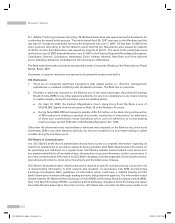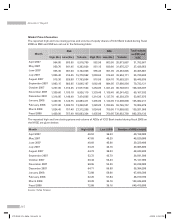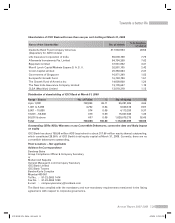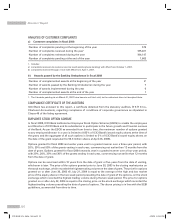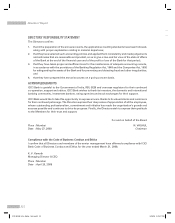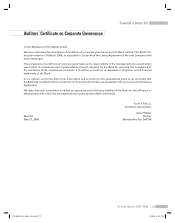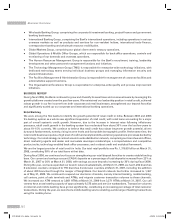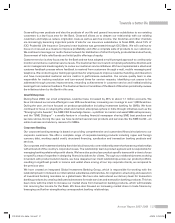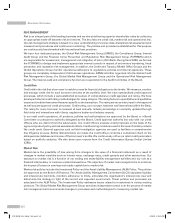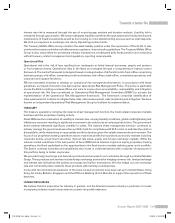ICICI Bank 2008 Annual Report Download - page 36
Download and view the complete annual report
Please find page 36 of the 2008 ICICI Bank annual report below. You can navigate through the pages in the report by either clicking on the pages listed below, or by using the keyword search tool below to find specific information within the annual report.
Business Overview
ECONOMIC OVERVIEW
The last year has witnessed significant developments in the global economy. Following the deterioration in the
US sub-prime housing loan market, the US economy is expected to experience a sharp slowdown in growth. The
Federal Reserve has reduced its forecast for US GDP growth in calendar year 2008 from the 1.3%–2.0% range
to between 0.3%–1.2%. Growth in the Euro zone remained above expectations at 0.8% in the first quarter of
calendar year 2008. However, downside risks to growth remain on account of adverse financial market conditions
and increases in energy and food prices. Growth in China moderated slightly during the first quarter of calendar
year 2008 to 10.6% as compared to 11.7% during the same period last year.
During fiscal 2008, the Indian economy continued on its high growth path, despite some moderation due to
difficult conditions in global markets and increasing inflationary pressures and monetary tightening. The Central
Statistical Organisation (CSO) put GDP growth at 9.0% during fiscal 2008 following the 9.6% GDP growth in
fiscal 2007, reflecting a slight moderation in growth of the economy. Growth in fiscal 2008 was driven mainly by
double-digit growth in the services sector and growth in the industrial sector. The Index of Industrial Production
(IIP) recorded an annual average growth rate of 8.1% in fiscal 2008, moderating from 11.5% in fiscal 2007. This
was mainly due to moderation of growth in the manufacturing sector from 12.5% in fiscal 2007 to 8.6% in fiscal
2008. The momentum of growth in the services sector (including construction) continued with 10.7% growth
during fiscal 2008 following the 11.2% growth in fiscal 2007. Growth in agriculture and allied activities increased
to 4.5% during fiscal 2008 as compared to 3.8% in fiscal 2007.
Inflation remained under control for most of fiscal 2008 with the annual average rate of inflation as measured by
the Wholesale Price Index easing from 5.3% in fiscal 2007 to 4.4% in fiscal 2008. However, inflationary pressures
picked up sharply from March 2008 with the year-on-year rate of inflation increasing from 5.1% for the week ending
March 1, 2008 to 8.8% for the week ending May 31, 2008. The sharp increase in inflation was mainly due to the
higher prices of primary articles, fuel group items and some manufactured products. The increase in inflation
was in line with global price movements. Global oil prices increased sharply during fiscal 2008, increasing
inflationary pressures experienced on this account. International crude oil prices increased from US$ 65.87 per
barrel at March 30, 2007 to US$ 101.58 per barrel at March 31, 2008 and further increased to US$ 135.90 per
barrel at June 13, 2008. In view of rising inflation, Reserve Bank of India (RBI) increased the Cash Reserve Ratio
(CRR) from 6.00% to 7.50% during fiscal 2008 and further to 8.25% effective May 2008.
India’s exports were US$ 155.5 billion during fiscal 2008, a growth of 23.0% over the previous year. During
April–December 2007, exports of agriculture and allied products recorded a growth of 34.9% and exports of
petroleum products recorded a growth of 37.3%. According to RBI, net invisibles receipts reached US$ 50.50
billion during the first nine months of fiscal 2008, a growth of 39.2% over the corresponding period in the previous
year. Growing import demand for capital goods due to the strong investment climate and the sharp increase in
oil prices have led to a deficit in the current account (US$ 16.05 billion during first nine months of fiscal 2008). Net
Foreign Direct Investment (FDI) into India was US$ 8.40 billion during the first nine months of fiscal 2008 while net
portfolio investment was US$ 33.00 billion. Foreign exchange reserves continued to grow, reaching US$ 309.16
billion on March 28, 2008.
The resilience displayed by the economy in fiscal 2008, in light of the developments in the global economy and
the sharp increase in global oil and commodity prices, is evidence of the broad-based and sustainable nature of
India’s growth momentum. The investment pipeline and demand for credit from corporates continue to be robust.
Inflation conditions, global developments and external inflows will be key factors impacting liquidity and interest
rates during the current year. Continued investment in infrastructure, reorienting education and skill-building to
the needs of the new economic drivers and holistic development of the agricultural sector and the rural economy
are the key imperatives to realise India’s full potential in the long run.
FINANCIAL SECTOR OVERVIEW
The financial sector mirrored the developments in the Indian economy. Credit growth during fiscal 2008 moderated,
given the tightening of interest rates in the economy. Non-food credit increased by 22.3% in fiscal 2008 compared
Business Overview
34
ICICI BANK_(Fin_Matter 1-64).ind34 34ICICI BANK_(Fin_Matter 1-64).ind34 34 6/20/08 5:03:07 PM6/20/08 5:03:07 PM


